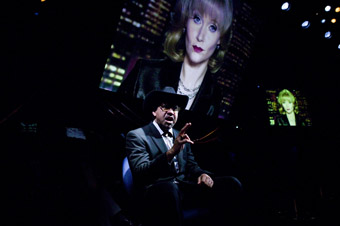gone to air but taken to account
bryoni trezise: sydney theatre company’s tot mom

Wayne Blair, Essie Davis, Tot Mom, Sydney Theatre Company
photo copyright Lisa Tomasetti
Wayne Blair, Essie Davis, Tot Mom, Sydney Theatre Company
THE RIGID, PREENED FACE OF US CRIME TV HOST AND EX-PROSECUTOR, NANCY GRACE (ESSIE DAVIS), OGLES US ELECTRONICALLY FROM FIVE SUSPENDED SCREENS. HER EYES PROJECT RIGHTEOUSNESS, HER LIPS AND CHIN CARVE OUT A THICK ‘UPPER INCOME’ GEORGIAN DRAWL WHICH MISTAKES ‘S’ FOR ‘SH’ AND WHICH SWALLOWS VOWELS ECHOICALLY DOWN INTO THE BACK OF HER THROAT AND OUT AGAIN. NANCY GRACE IS A MEDIA MONSTER WHO SEEMS TO WANT “AYVERYONE”—WHETHER GUILTY OR NOT—”TO HAYVE THAYRE DAY IN COURRT.”
Oscar-winning film director Steven Soderbergh (Traffic, Che) had to travel all the way to Australia, and all the way to verbatim theatre, to air his version of the murder of Orange County’s toddler Caylee Anthony and ensuing media trial of her mother in the Sydney Theatre Company production, Tot Mom. The child’s disappearance was reported by her mother Casey Anthony (now indicted for first-degree murder and facing the death penalty if convicted) one month after Caylee had gone missing. Six months later, the child’s bagged and duct-taped body was found in a wooded area “only a stone’s throw”, as Grace repeatedly reminds us, from the Anthony residence.
Grace is best known in the US for Nancy Grace, the ratings-topping HLN program featuring breaking crimes news with lashings of innuendo from a variety of favourite experts. Night after night, Grace remounts the sordid debris of Florida’s rapes, murders and disappearances—skulls falling from plastic bags, the forensics of hair and skin, tears or dry eyes in a suspect—in her tightly conservative, scandal-bound media script. Her tactics are savage, banal and flush with the rhetoric of victim advocacy at the expense of due diligence and civil liberty. It seems she’d get on well with Sarah Palin, although it’s a marvel there’s space for two of their ilk in the world.
We are told that all words in the piece derive from transcripts—not the preciously undisclosed transcripts of witness testimony, but of nightly US TV verbiage, mixed with documents from the public record. What insight can live verbatim theatre bring to such a highly mediated event? Why theatre? Why verbatim? Why here?
Documentary theatre has been traditionally used to advantage minority voices and rights (Urban Theatre Projects’ Fast Cars and Tractor Engines [RT70), Alana Valentine’s Parramatta Girls). We’ve also seen the reversal of this convention in works like version 1.0’s CMI: A Certain Maritime Incident (RT61) and David Hare’s Stuff Happens, which take words out of the mouths of those in power to re-quote the quotation and let the rhetoric be heard. In Aalst, Duncan McClean shifted tactics again, deploying the chilling testimonies of two parents charged with infanticide to tempt our moral incredulity over the social psychology of good and evil (RT83).
Soderbergh’s strategy departs from these by remediating the already mediated: he re-screens words that have already, so to speak, gone to air. He saves these words from disappearance and brings them to account. They are made distinctly temporal, and although we never see Grace in the flesh, they are also made distinctly corporeal—they flash between the TV program’s interviewees (who are physically present, seated in a row beneath the screens and never seen on them) and Grace’s indomitable screen presence.
The text runs at hammer pace. Grace calls a bounty hunter, a psychoanalyst, a police detective and a defence attorney, amongst others, to her program—all excruciatingly facile in their observations. The structure of the work follows Grace’s shifts between these experts, eye witness news reportage and call-in viewers, to mount a crescendo of conjecture around the crime itself. At times the rhythm in Grace’s speech overtakes her meaning—she is given a parodic edge that makes her both larger than life and extraordinarily real. The staging is simple—a bog upfront reminds us of the missing child—and lighting is expertly timed to puncture Grace’s false solemnity with a perfunctory cut, black-out and edit to the next scene.
The performances are powerfully economical. Essie Davis creates Grace solely through manipulations of voice and face, her chin muscles often taut with purpose, her lips and eyes ready to pounce. The other performances are also compelling, with multiple character portrayals drawn through minimal costume changes. Wayne Blair stands out as the redneck bounty hunter Leonard Padilla and Darren Gilshenan for his depiction of hapless criminal defence attorney Mark Nejame.
The Anthony case became a witch hunt in the US, owing to media overexposure. In Australia, Tot Mum has been interestingly met with a degree of hostility (see http://www.sydneytheatre.com.au/2009/tot-mom/talkback/), with claims that Soderbergh is capitalising on someone else’s grief. (By playing only in Sydney he allegedly avoids compensation fees for the American figures in the play). That Grace is co-author of a bestseller on how “24/7 Media Have Hijacked Our Criminal Justice System” is no little irony. With the trial to begin in June 2010, Soderbergh’s account is an oddly timed intervention that contemplates this very topic. His is a ‘trial’ of the media ‘pre-trial’, but we are still a long way from knowing the legal outcome of Casey Anthony’s fate, and likewise, from hearing her story should it be told.
Tot Mum, director, creator Steven Soderbergh, performers Wayne Blair, Zoe Carides, Essie Davis, Darren Gilshenan, Glenn Hazeldine, Genevieve Hegney, Damon Herriman, Peter Kowitz, Rhys Muldoon, Emma Palmer, set design Peter England, costumes Tess Schofield, lighting Damien Cooper, sound Paul Charlier, Sydney Theatre Company, Wharf Theatre, Dec 23, 2009-Feb 7, 2010
RealTime issue #95 Feb-March 2010 pg. 43






